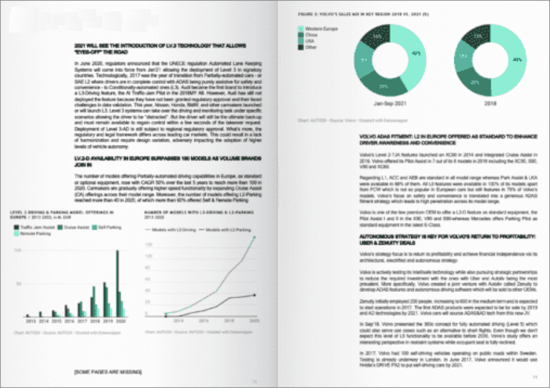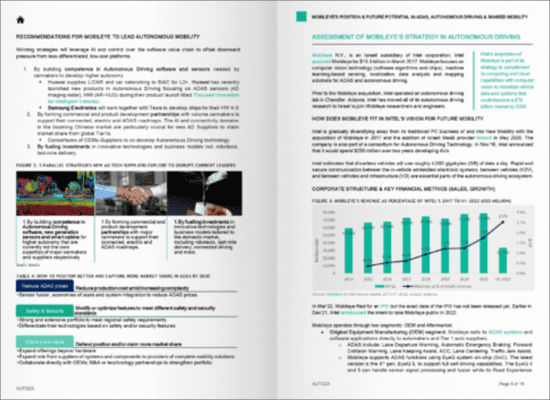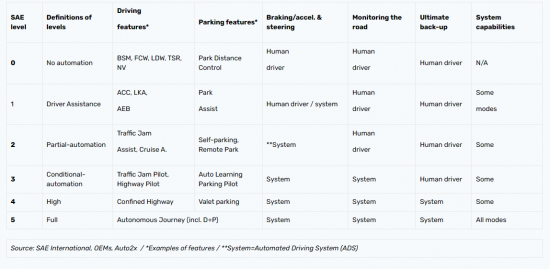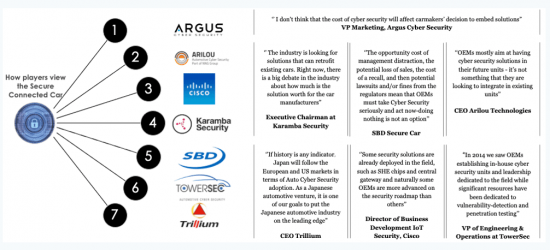 |
市場調査レポート
商品コード
1302350
レベル3~4自動運転、自動車サイバーセキュリティ、V2X、AIに対する規制ロードマップRegulatory Roadmaps to Level 3 - 4 Autonomous Driving, Automotive Cyber Security, V2X & AI |
||||||
| レベル3~4自動運転、自動車サイバーセキュリティ、V2X、AIに対する規制ロードマップ |
|
出版日: 2023年05月12日
発行: Auto2x
ページ情報: 英文 100 Pages; 50 Tables & Graphs
納期: 即日から翌営業日
|
- 全表示
- 概要
- 目次
当レポートでは、自動車市場について調査分析し、監視運転から条件付き・完全監視なし運転(SAEレベル3~5)への移行に対する規制情勢や、欧州・米国・中国・日本・英国・その他の地域の規制の義務化と政策のロードマップとスケジュールなどを提供しています。
サンプルビュー


目次
エグゼクティブサマリー
- レベル4自動運転規制が準備中
- ドイツ、ロボタクシーと自動運転シャトルを市場に投入するためのL4規制を可決
- 米国はAVテストイニシアチブの拡大によりAVテストの明確性を強化
- UNECEの規制改正により、2021年にレベル3自動運転がついに許可される見込み
- 自動車サイバーセキュリティは必須になりつつある
- ICVに対する中国の取り組みにより、規制変更が迅速に行われる可能性がある
- L3自動モードで発生した事故に由来する保険請求を支援するデータストレージ
- 予防安全規制により、ADASの普及と乗客のモニタリングが促進される
第1章 SAE Lv.3・Lv.4システムに対する自動運転規制
- 自動運転規制:現在と将来の技術と規制とのギャップ
- 規制プロセスと自律性への競争における本質的な違いにより、調和の欠如に対する懸念が生じる
- 規制は展開にどのような影響を与えるか。L3展開に適した地域
- UNECE:UN R79の修正と水平規制
- ドイツが支援的なADフレームワークにより欧州でのAD展開を主導
- 英国が世界のADハブとして競合する機会:イノベーション、テスト、展開
- 米国の柔軟でありながら安全性と調和に懸念のある自動運転規制枠組み
- 中国のインテリジェントコネクテッドビークル(ICV)規制
- 日本のAD規制情勢
- その他の主要市場におけるAD規制の動向の概要
- 欧州
- アジア・アジア太平洋・北米・南米
第2章 ADAS L1~L2・NCAP Lv2等級に対するアクティブセーフティ規制
- ADASのUX/UIによる、運転者の注意散漫、混乱、誤用の問題
- UN GSRIIが運転者の注意力散漫に対処するための予防安全装置を義務付け
- EuroNCAPのハイウェイアシスト/Lv.2機能に対する2020年の評定
第3章 SAEレベル3条件付き自動化におけるデータ記録と責任
- 自動運転イベントデータレコーダーが必要な理由を学ぶ
- L3のデータ記録と保管に関する規制上のガイダンスが未熟である
- L3車両自動化は保険バリューチェーンに課題と機会をもたらす
第4章 主要自動車市場における自動車サイバーセキュリティ規制
- 新しい規制により、自動車サイバーセキュリティの展開と標準化が促進される
- 米国の自動車サイバーセキュリティ規制措置
- 自動車サイバーセキュリティに関する国連(国際)規制:EU・日本
- ソフトウェア更新とその管理システムに関する2つの新しい国連規則
- ISO/SAE 21434:自動車サイバーセキュリティを調和させるための共同規格
- コネクテッドカーを保護するにはどのような規制/法的措置が必要か
- V2X通信に向けたサイバーセキュリティ
第5章 Vehicle-to-Everything V2X:V2V-V2I規制
- V2V・V2I通信は交通安全にどのように役立つか
- V2VはHAVの技術の前提条件ではありませんが、安全性を強化できる
- 最先端:V2V・V2Iは今日すでに実用化されている
- V2V-V2I規制ロードマップ:国連・米国・中国
- DSRCベースのV2V・V2Iのセキュリティとプライバシー
- AutotalksのCTOによるV2Xの規制活動に関する考察
第6章 自動車向けAIに関する規制
- 欧州委員会が「高リスク」AIアプリケーションを規制する初の試み
- AIの倫理規定:BMW Group・Continental
付録:レポート内の規制と法律の概要
Regulatory Roadmaps unveil the transition to autonomous, secure and Connected Car. Read this report to learn about
- The status of the regulatory landscape for the transition from Supervised to Conditionally & Fully-Unsupervised-Driving (SAE Level 3-5).
- The mandatory features of Active Safety, regulations for V2X, and ethical AI.
- Roadmaps and timelines of regulatory mandates and policies in Europe, the USA, China, Japan, the UK and other geographies
- The impact of regulation on market competition and technology adoption
SAMPLE VIEW


The lack of a harmonized regulatory framework for Level 4-Automated Driving restricts deployment
The lack of harmonization of Autonomous Driving regulation across major car markets remains the key roadblock to the deployment of L3-4.
Carmakers and developers of autonomous driving technology face compliance regulatory requirements that are different across major car markets. For example, for countries such as Japan, China, and the EU members that are signatories of the UNECE regulation, there is no framework for type approval of Level 4.
- Germany, was one of the first countries globally to allow testing of L4 but this applies to robotaxis and autonomous shuttles, not private car ownership.
- On the other hand, the U.S follows self-certification with relevant FMVSS & voluntary guidelines for L4 testing and deployment but there is no federal regulation in place.
- In Apr'22, Japan revised its traffic rules for Level 4 autonomy with enforcement from May 2023.
SAE Lv.4-Full automation describes the scenario where drivers can completely hand over vehicle control and monitoring to the Automated Driving System for specific driving scenarios under the Operational Design Domain of the systems, e.g. Lv.4-Parking Valet parking or L4.-Driving Cruising Chauffeur.
Until today, the only vehicles allowed to operate in Lv.4 Autonomous Driving are robotaxis from Waymo and others. In private car ownership, the highest level of autonomous driving available in the market is Level 3-Conditional Automation.
Regulatory amendment in UNECE finally allowed Level 3-Autonomy in 2021 but global deployment is still fragmented
After almost 3 years in the making, the amendment of UNECE Reg. No.79-Steering Equipment will allow Level 3 in countries adopting the new rules called "Automated Lane Keeping System".
The ALKS regulation is set to apply to 60 countries including the UK, Japan, and EU member states from January 2021, to enable the safe introduction of 'Level 3' automation features in certain traffic environments.
UN regulations manage pre-sale Type Approval, i.e. the Regulation sets out clear performance-based requirements that must be met by car manufacturers before ALKS-equipped vehicles can be sold within countries mandating the Regulation.
"UNECE's Automated Lane Keeping System regulation is applicable for LEVEL 3, for low-speed (60 km/h) highway-only"
We see Europe and Japan benefiting from the changes in regulation due to the combination of technological capabilities in Level 3 from their domestic carmakers and the favorable political framework to remove roadblocks and establish their respective markets as key innovation hubs.
What are the key challenges in the amendment of regulatory requirements for higher levels of Autonomous Driving?
- As automotive and technology players race to develop and deploy higher vehicle autonomy to unlock enhanced safety in passenger cars and commercial vehicles, new revenues (pricing models of Lv.4, AMoD) and USPs, the slow amendment progress of regulation and the lack of harmonization create barriers for their commercialisation strategies
- Regulation needs to transition from driver-centric to Automated Driving Systems (ADS) to allow today's Supervised driving (SAE Level 0-2) to shift to Conditionally (SAE Lv3) & Completely-Unsupervised driving; (Lv.4-5). But lack of regulatory standardization across major car markets will create regional hubs (aka "islands", such as cities where technology is allowed) and require design variation from OEMs
- The vehicle automation mix is changing with the proliferation of Lv2 driving features. In 2020, Euro NCAP released the ratings of 10 Lv.2 / Highway Assist systems marking Audi's Q8, BMW 3, and GLE "Very Good".
- With the introduction of Lv.3 allowing Conditionally-Unsupervised driving and vehicles with different levels of autonomy co-existing on the road, clear safety requirements are needed in the form of standardized, international AD regulation which could mitigate scepticism of higher vehicle autonomy.
The transition from driver-centric regulation to Automated Driving Systems will allow the shift from Supervised driving to Conditionally (Lv3) & Completely-Unsupervised driving
Admissibility of automated driving functions depends on the driving and monitoring tasks, i.e. driver engagement, which can be derived by (or inferred by) the level of vehicle automation (SAE J3016 or BASt).
2016-17 saw a shift in the focus of regulation from approving pilots and testing of technologies falling under SAE Level 3/4 to discussion for amendments or event action to enable deployment of Level 3 on public roads. The most evident example was the amendment of the German Road Traffic Act which allows Level 3 from Sep'17, once these systems are type-approved by UNECE regulations.
Meanwhile, the amendment of Regulation No.79 has progressed in Europe to approve Level 3 features under ALKS.
Finally, the world's largest car market in terms of sales, China, released April 2019, national regulations on-road tests for Autonomous Vehicles as a part of a broader drive to excel in the development of the technology and gain an advantage in the commercialization of autonomous driving technology. This comes after China halted Autonomous Vehicle trials on public roads until relevant standards for Intelligent Connected Vehicles (ICVs) come to force.
We expect regulatory action to accelerate in the remainder of 2020 as key car markets boost their efforts to lead the global Autonomous Vehicle scene -but also guarantee safe and secure deployment.
In this report, we define Autonomous Driving regulation as the regulatory and legal developments regarding the transition from a ''driver-centric'' regulation, which includes
- the "assistive" or "Supervised" ADAS / SAE Level 0-2,
- to "Conditionally" (SAE Level 3)
- & "Completely-Unsupervised" driving (Level 4-5) with or without driver controls, which are in the epicenter of regulatory developments because they will allow (limited to specific use cases or full) hands-off the steering wheel, eyes-off and eventually brain-off.
- In addition to approval and homologations, this framework also includes the transfer of liability from the driver to the ADS as well as issues around Automotive Cyber Security and V2V-V2I.
Levels of Automation based on SAE International's new standard J3016

Active Safety Regulations will push ADAS penetration & passenger monitoring
Upcoming regulatory & market requirements push for the expansion of monitoring from drivers to occupants & drive holistic cabin sensing
By mid-2022, all motor vehicles (incl. trucks, buses, vans and sport utility vehicles) in the EU will have to be equipped with Driver Monitoring Systems to mitigate drowsiness and distraction. The regulations will apply 30 months after entry into force with a longer application date provided for a limited number of features in order to allow OEMs to adapt their production to the new requirements.
Automotive Cyber Security becomes mandatory
Over the next decade, as transportation progresses from Connected and Partially-Automated to Highly and Fully-automated, Smart and Shared Mobility, the addition of new sensors and ECUs, new architecture, more Connected devices and V2X will significantly enlarge the vehicle ''attack surface". Identifying, mitigating and responding to cyber threats will not only be paramount for physical road and vehicle safety but also a prerequisite for the transition towards self-driving cars.
ALKS will also need to comply with cyber-security and software update requirements set out in two other new U.N. regulations. In more detail, two new regulations on automotive cybersecurity and software updates to establish clear performance and audit requirements for OEMs are coming into effect in Jan'21.
The 1st is the "UN Regulation on Cybersecurity and Cyber Security Management Systems" and the 2nd the "UN Regulation on Software Updates & Software Updates Management Systems".

Table of Contents
Executive summary
- Level 4-Autonomous Driving Regulation in the works
- Germany passes regulation for L4 to bring robotaxis & autonomous shuttles to market
- The U.S enhances the clarity of AV testing with the expansion of its AV TEST INITIATIVE
- Regulatory amendment in UNECE will finally allow Level 3-Autonomy in 2021
- Automotive Cyber Security is becoming mandatory
- China's commitment to ICVs could fast-track regulatory changes
- Data Storage to help insurance claims from accidents occurring in L3 automated mode
- Active Safety Regulations will push ADAS penetration and passenger monitoring
1. Autonomous Driving regulation for SAE Lv.3 & Lv.4 systems
- Autonomous Driving regulation: the gap between current and future technology vs regulation
- Inherent differences in regulatory process & race to autonomy raise concerns over the lack of harmonization
- How does regulation affect deployment? Favourable geographies for L3 deployment
- UNECE: The amendment of UN R79 vs a Horizontal regulation
- The amendment of the 1968 Vienna Convention on Road Traffic
- The amendment of UN R79 is the critical step towards self-steering systems that will unlock Level 3-4
- Automated Lane Keeping Systems (ALKS) regulation for Lv.3
- Three consequences arising from the delay of R79's amendment
- European Autonomous Driving Forecast: L1-L4 car sales up to 2025
- Germany to lead AD deployment in Europe driven by supportive AD framework
- Level 3 automated driving to become legal in Germany from autumn 2017
- Review of Germany's AD Ethical Guidelines
- Opportunities for the UK to compete as a global AD hub: innovation, testing, deployment
- Overview of the UK's AD regulatory activity
- Flexible Autonomous Driving regulatory framework in the USA but concerns over safety and harmonisation
- L3 deployment strategy in the U.S based on the regulatory landscape
- The USA has opened up the road to L3-5 with voluntary guidelines
- Assessment of USA AD policy: Guidelines (voluntary) vs Regulation (mandatory)
- Action to harmonise state law: LEAD'R Act & SELF-DRIVE Act
- China's regulation for Intelligent and Connected Vehicles (ICVs)
- Status of AD regulation in China & roadmap for ICV standards
- Concerns over the regulatory action needed in China
- Japan's AD regulatory status
- Summary of AD regulatory developments in other leading markets
- Europe
- Asia, Asia-Pacific & North and South America
2. Active Safety Regulation for ADAS L1-L2 & NCAP Lv2 rating
- The problem with driver distraction, confusion or misuse because of ADAS UX/UI
- UN GSRII mandates Active Safety equipment to tackle driver distraction
- EuroNCAP's 2020 rating for Highway Assist / Lv.2 features
3. Data recording & liability in SAE Level 3-Conditional Automation
- Learn why we need Automated Driving-Event Data Recorders
- Regulatory guidance on data recording and storage for L3 is immature
- L3 vehicle automation presents challenges & opportunities for the insurance value chain
4. Automotive Cyber Security Regulation in major car markets
- New regulation will push for the adoption and standardisation of Auto Cyber Security
- Automotive Cyber Security regulatory action in the USA
- UN (International) Regulation on Auto Cybersecurity: EU & Japan
- Two new UN Regulations on Software Updates & their Management Systems
- ISO/SAE 21434: a joint standard to harmonise Auto Cyber Security
- What regulatory/legal action is needed to secure Connected Cars?
- Cyber Security for V2X Communications
5. Vehicle-to-Everything V2X: V2V-V2I Regulation
- How could V2V and V2I communications help towards road safety?
- V2V isn't a technical prerequisite for HAVs but can enhance their safety
- State of the art: V2V & V2I are already on the road today
- V2V-V2I regulatory roadmap: UN, USA and China
- Security and privacy in DSRC-based V2V and V2I
- Insights on the regulatory activity for V2X with CTO of Autotalks
- V2X deployment status raises concerns over the lack of harmonization
- Learn how regulatory guidance for V2X will evolve in major markets
- Weighting in the debate between DSRC / ITS-G5 and C-V2X
- Understand which V2X-supported features will come to market first
- Winners from the installation of V2X sensors & infrastructure
6. Regulation for Artificial Intelligence in Automotive
- European Commission's first attempt to regulate "high risk" AI applications
- Ethics regulations for AI: BMW Group and Continental
